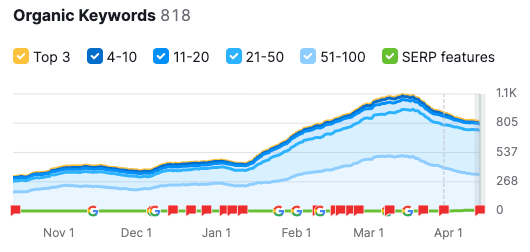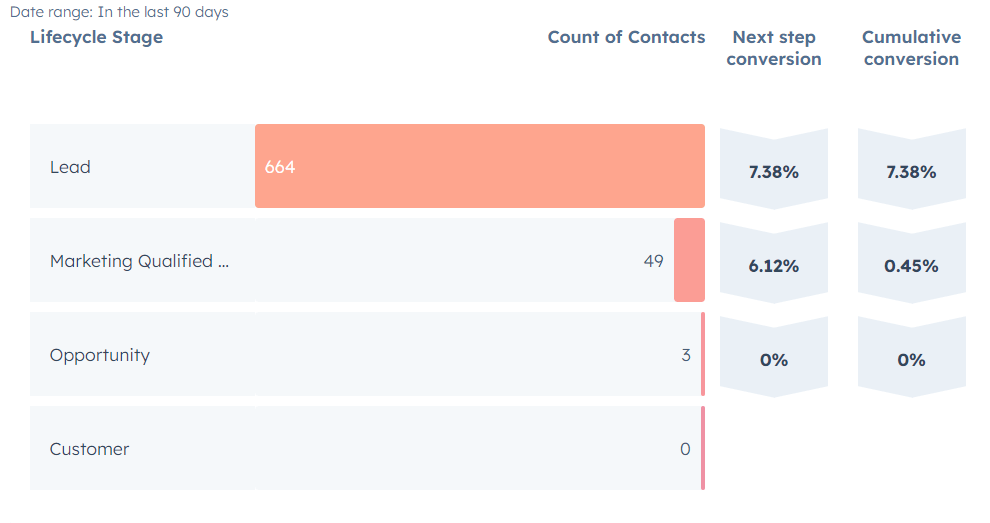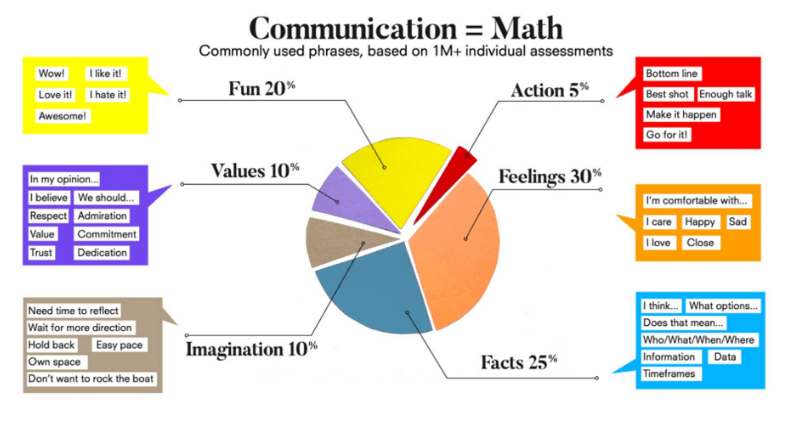How To Make Data-Driven Marketing Decisions (With Examples and Results)

Data-driven marketing adds the objective flair that humans can't achieve. It allows us to reveal what works, ditch what doesn't, and discover areas to innovate. It's not nice-to-have benefits. They are the key to continuous growth, especially during times of low resources and high expectations.
But chances are you already know that. So rather than writing paragraphs convincing you to shift or reminding you to always stick to a data-first approach, we'll let real case studies persuade you.
The first story is about a B2B service company that worked with O8. In one month, their inbound traffic increased by 247%, and they got 15 inbound leads after switching to a data-first approach.

Before our engagement, they weren't using HubSpot, Google Analytics, or any tool that tracks customer, marketing, or sales data. They understood the benefits of monitoring data but didn’t have time to set up a measuring system. So they trusted their intuition when making marketing decisions.
At times, this led to profitable decisions. But, in other instances, it led to results lower than they could have been if they had data.
At O8, we have a saying that goes, don't do shiny things for the sake of sparkle. So we became curious about what their target audience looked like, sounded like, and needed. We listened to what their team had but searched for data that backed their beliefs:
- We did consumer research to define accurate profiles
- A user experience (UX) analysis to learn how visitors interacted with the website
- An SEO and content audit to see if they were producing the right content to turn visitors into customers.
We found out there was room to improve how we communicated online. For example, we discovered that our client's customers often searched for a close variation of an existing keyword the company was missing out on. In reality, the newfound term was how users were searching for our client's services. With this in mind, we wrote new articles that resonated with the exact needs of those searching for this new keyword.
247% more inbound traffic and 15 inbound leads in one month after embracing a data-first approach
Interchanging these terms might sound like a minor tweak, but it's not. About 30 people each month search for the first keyword — with 3600 people searching monthly for the revised keyword.
We presented this data to them and got their buy-in, as they were motivated to make data-driven marketing decisions.
Three months later, their inbound traffic increased by 247%. They also received 15 inbound leads in the first month for services with an average annual deal size of $100,000.
3 reasons companies don’t make data-driven decisions
Even after learning the benefits of data-driven decisions, some companies won't make them. We didn't understand why in our earlier days. Why would someone cross a hanging bridge with a blindfold on? Dozens of projects later, and we found three reasons.
Reason #1: Companies don’t have data to guide their decisions
Not every company is measuring the impact of their marketing, and we don't blame them. Social platforms punish trackable links, don't tell you where 30% of their traffic leads, and browsers block third-party cookies. No wonder digital marketing expert Rand Fishkin told marketers not to track anything during Ad World 2023. Measuring is complex, confusing, and not always possible.
Solution #1: Measure what you can measure
You might not be able to track every touchpoint. But tracking some of them is crucial to avoid focusing on the wrong initiatives.
For example, look at the following chart from one of our clients. It shows the percentage of leads that turned into MQLs, opportunities, and customers in the last 90 days.

Without this data, the client could push us to ramp up marketing to find more deals. But data reveals 0.45% of inbound leads turn into potential opportunities. This makes us ask ourselves, do we have a marketing or sales issue:
- Do we lack social proof?
- Why isn’t our sales team closing leads?
- Are we turning down potential marketing-qualified leads?
- Are leads truly prospects, or are we misqualifying people?
- Is our mission, purpose, and positioning attracting the right people?
This one graphic made us realize a misalignment between the needs of our client’s target audience and their marketing efforts. A single data point that made us shift our positioning and see the benefits of doing so.
Any relevant data is better than no data. But if you can only choose between five, try to make it one of these:
- Deal velocity
- Inbound leads per quarter
- Revenue generated vs. goal
- Revenue per inbound and outbound pipelines
- Most profitable cross-platform inbound campaigns
- Conversion rate from lead to marketing qualified lead to customer
We track these six data points for every client, regardless of their industry, company size, and niche.
Reason #2: Data can be arid and uninspiring
Not everyone thinks, speaks, or makes decisions based on data. Some people react better to beliefs, emotions, and dreams.
This has two major implications. First, the personality of those in charge of using the data influences its value. People who don't speak data might not know how to translate it into successful marketing campaigns. Conversely, those who talk data might not know how to translate information into a marketing campaign that those who don't value data will appreciate.
Many companies ignore data because of this dilemma. It is scary to think they might improperly extract or present the wrong insight and mess everything up.
Solution #2: Use the Process Communication Model (PCM)
Expert communicators like Pixar, NASA, and Bill Clinton use the PCM. It guides communicators on the language and tone they should use to appeal to six types of human personalities. So while you can't change the information you value, you can use the PCM to communicate what you do with that data in a way that most people find engaging.

In Hook Point, growth hacker Brendan Kane shares an example of a car ad that follows PCM to appeal to every audience:
- “Think of a car. This car model gets 50 miles per gallon. The car's miles per gallon are at the highest rate compared to other models in its class." These sentences use LOGIC and speak to Thinkers.
- "We believe that this car provides more value to our customers in regard to what you're going to pay for." This sentence uses VALUE and speaks to Persisters:
- "Bottom line—it's the best car on the market." This sentence uses CHARM and speaks to Promoters.
- "It feels good, it looks nice, and you're going to be so comfortable driving this car." This sentence uses FEELINGS/COMPASSION and speaks to Harmonizers
- "All your friends are finally going to want to hang out with you because this car is awesome.” This sentence uses HUMOR and speaks to Rebels.”
Reason #3: Data can make us overlook human opinions
Sometimes, data-first companies overlook human creativity, opinion, and intuition. This results in companies missing out on innovative projects and becoming risk-averse. Ironically, this reduces the number of data points they have to judge initiatives because they are always doing more of the same.
Solution #3: Realize that data and humans can co-exist
Data sets the starting point of the right path. But you are in charge of detecting its blind spots, looking at the big picture, and knowing when to take risks.
- Four years ago, quantitative data would have suggested that the AI software market was too small to invest in. Those who let their human intuition refute this insight now lead the AI space. And now they have the data to prove it.
- Conversely, human intuition told Tropicana to change its packaging. The lack of data backing this decision cost them $30 million in sales and forced them to return to their original design.
Opinions provide subjective and qualitative insights, while data provides objective quantitative ones. Instead of having both sides compete with each other, let them work together.
Calculate the ROI of a data-driven marketing strategy
There are many roads to get from point A to point B. If your goal is to get to the finish line, it doesn't matter the one you choose. But if you wish to learn how to get from one side to the other in the most affordable and fastest way, start collecting sales, marketing, and customer data.
Out of all the Customer Relationship Management (CRM) systems, we like using HubSpot to track and attribute data.
Before using it, we struggled to track every step of the customer’s journey. Visitors would fill out a form but not engage with our marketing team. Our sales team got on calls with potential new customers without knowing exactly what the prospects knew or expected about us. We tried to use many tools and data sources to fill these gaps, but navigating between platforms became overwhelming and unscalable. HubSpot simplified everything by giving us a single-source-of truth from which to guide decisions on social media, email, and content.
Use the following free HubSpot ROI calculator to determine the potential ROI from subscribing to Marketing Hub and start making informed decisions around your social media, advertisement, email, and content marketing. Don't hesitate to contact us if you need help explaining projections and their accuracy.







